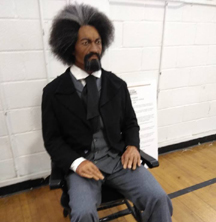As much as we think we know about the best-known Black man in 19th century America, many will still be quite surprised to learn that he did, indeed, visit the continent of his enslaved ancestors. As part of a "European Tour" that he and his second wife, Helen Pitts Douglass, took in 1886 - 1887, Douglass, in Chapter IX of his 1892 biography (the final version) admitted that he had more on his mind than witnessing the frothy spectacles of the capitals of Europe:
"I confess, however, that my desire to visit Egypt did not rest entirely upon the basis thus foreshadowed. I had a motive far less enthusiastic and sentimental; an ethnological purpose in pursuit of which I hoped to turn my visit to some account in combatting American prejudice against the darker colored races of mankind, and at the same time to raise colored people somewhat in their own estimation and thus stimulate them to higher endeavors."
It took the Douglasses four days in calm seas to sail from Naples, Italy to Port Said, Egypt. There, at the entrance to the Suez Canal, he closely observed all the maritime activity around him but took special note of the work habits of the Arab stevedores: "It was something to see these men of the desert at work. As I looked at them and listened to their fun and frolic while bearing their heavy burdens, I said to myself: 'you fellows are, at least in your disposition, half-brothers to the negro. The negro works best and hardest when it is no longer work, but becomes play with joyous singing. These children of the desert performed their task in like manner, amid shouts of laughter and tricks of fun, as their hard work was the veriest sport."
Frederick Douglass in Africa, Part 1
Praising the Past


Douglass noted their variations in skin color, other aspects of their physical appearance, and the signs of endemic poverty. His day and a half passage through the Suez Canal onboard the "Ormuz" which he said was the largest vessel that had then ever traversed the channel, made him introspective and poetical:
"Slowly and carefully moving through the canal an impressive sight was presented to the eye. Nothing in my American experience ever gave me such a deep sense of vast, profound, unbroken sameness, and solitude...moving smoothly and noiselessly between two spade-built banks of yellow sand, watched over by the jealous care of England and France, two rival powers jealous each of the other.... After more than a day and a night on this weird, silent, and dreamy canal under a cloudless sky, almost unconscious of motion, yet moving on and on without pause and without haste, through a noiseless, tireless, houseless, and seemingly endless wilderness of sand, where not even the crowing of a cock or the barking of a dog is heard, we were transferred to smart little French steamer and landed at Ismalia, where, since leaving the new and shambling town of Port Said, we see the first sign of civilization and begin to realize that we are entering the land of the Pharaohs."
Coming: Frederick Douglass at the Pyramids - Part 2 in the series.
"Slowly and carefully moving through the canal an impressive sight was presented to the eye. Nothing in my American experience ever gave me such a deep sense of vast, profound, unbroken sameness, and solitude...moving smoothly and noiselessly between two spade-built banks of yellow sand, watched over by the jealous care of England and France, two rival powers jealous each of the other.... After more than a day and a night on this weird, silent, and dreamy canal under a cloudless sky, almost unconscious of motion, yet moving on and on without pause and without haste, through a noiseless, tireless, houseless, and seemingly endless wilderness of sand, where not even the crowing of a cock or the barking of a dog is heard, we were transferred to smart little French steamer and landed at Ismalia, where, since leaving the new and shambling town of Port Said, we see the first sign of civilization and begin to realize that we are entering the land of the Pharaohs."
Coming: Frederick Douglass at the Pyramids - Part 2 in the series.
Advertisers | Contact Us | Events | Links | Media Kit | Our Company | Payments Pier
Press Room | Print Cover Stories Archives | Electronic Issues and Talk Radio Archives | Writer's Guidelines






